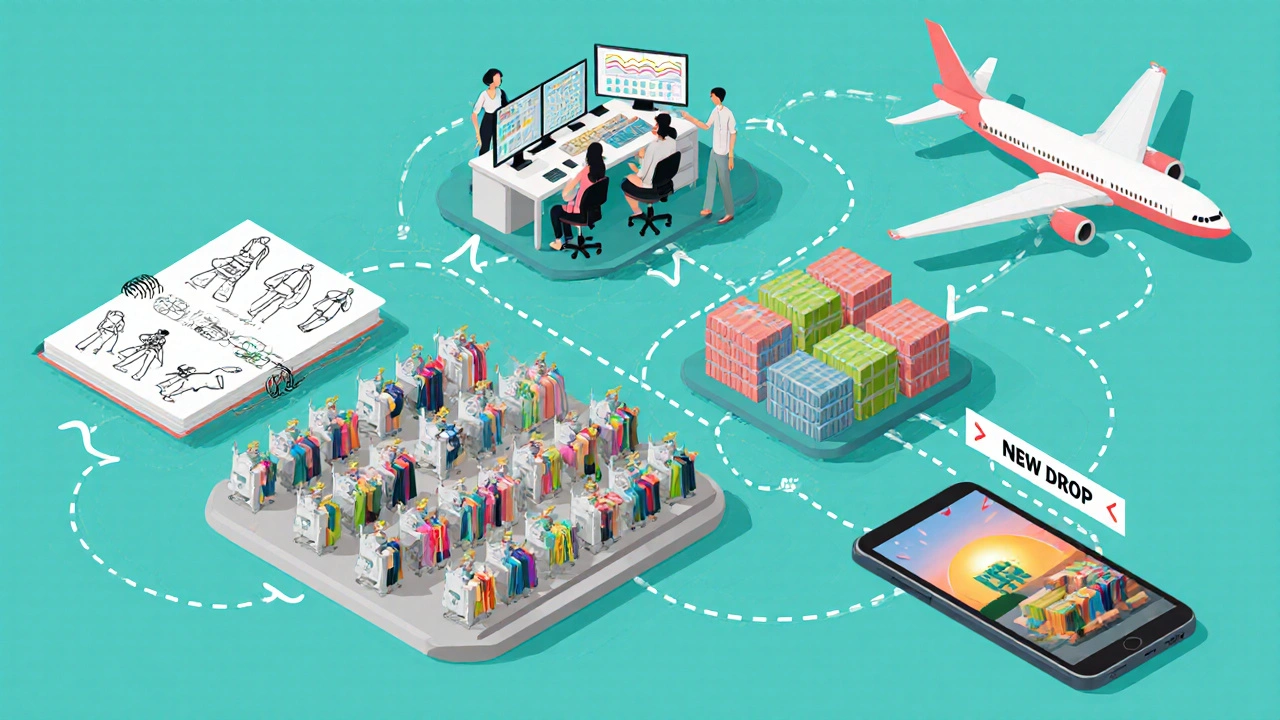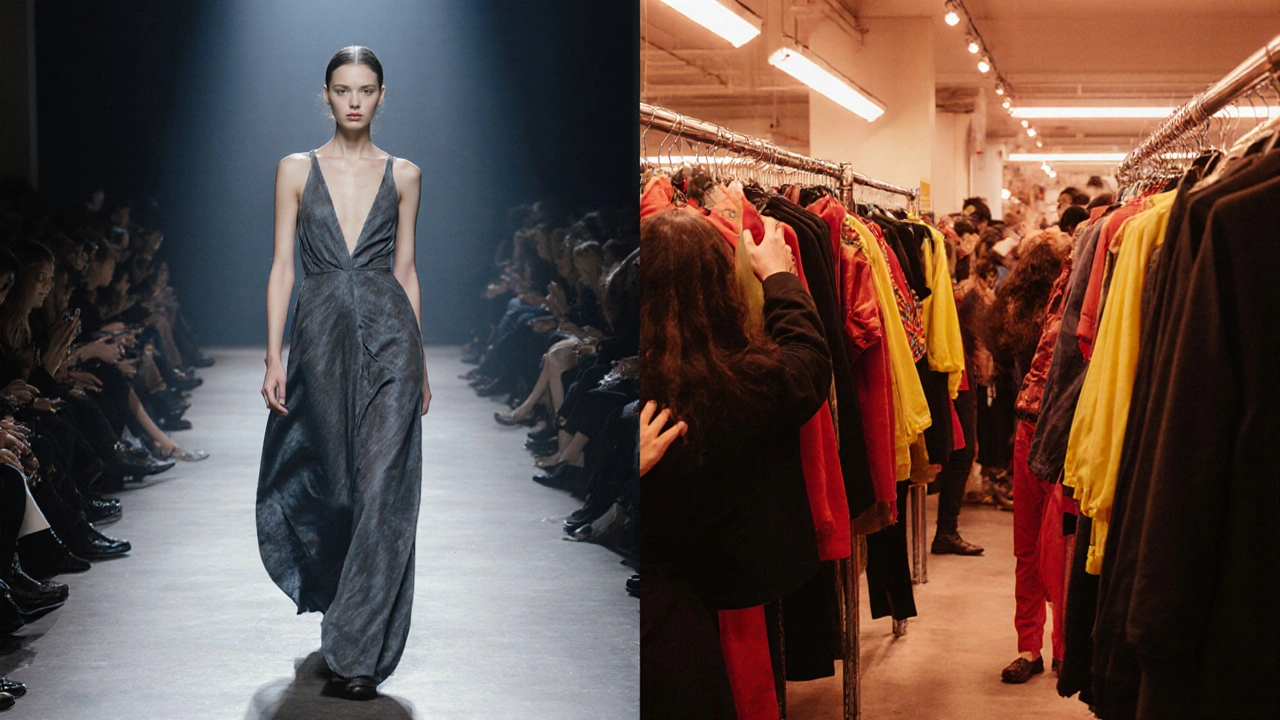Fast Fashion Impact Calculator
How much does your wardrobe impact the planet?
This tool calculates your environmental footprint based on your clothing habits, comparing fast fashion versus sustainable alternatives.
Your Impact
Based on your clothing habits, here's your environmental footprint comparison:
Water Usage
Fast fashion: liters per year
Sustainable option: liters per year
Carbon Emissions
Fast fashion: kg CO₂ per year
Sustainable option: kg CO₂ per year
Waste Generated
Fast fashion: kg per year
Sustainable option: kg per year
Your Action Plan
Ever wonder why you see the same runway looks on the streets within weeks? That’s the power of fast fashion - a business model that churns out runway‑inspired pieces at breakneck speed. In this guide we’ll break down exactly what fast fashion means, trace its roots back to the early 2000s, and show how celebrity culture accelerated the craze.
Defining Fast Fashion
Fast fashion is a fashion production approach that copies high‑end designs and pushes them into stores within weeks, sold at low price points. Unlike traditional seasonal collections that debut twice a year, fast fashion cycles can be weekly, giving shoppers a constantly refreshed inventory.
The model relies on three pillars: rapid design turnaround, low‑cost manufacturing, and aggressive marketing that taps into consumers’ fear of missing out.
How the Trend Began: A Timeline
The seeds were sown in the late 1990s when European retailers started experimenting with quicker turnarounds. Two key milestones mark the rise of fast fashion:
- 1999-2005 - The Zara Effect: Spanish chain Zara pioneered a “design‑manufacture‑distribution” loop that could move a garment from sketch to store in just 15 days. This speed set a new industry benchmark.
- 2006-2010 - Global Expansion: Swedish giant H&M opened thousands of new stores and launched its “Conscious” line, which paradoxically highlighted sustainability while still riding the fast‑fashion wave.
By 2013, ultra‑fast fashion brands like Shein and Boohoo entered the scene, leveraging online‑only models and AI‑driven trend forecasting to cut lead times to under a week.
The Celebrity Connection
Celebrity outfits have long influenced consumer behavior, but the synergy with fast fashion exploded in the 2010s. When a star steps out in a designer dress, social media platforms turn that image into a meme, a hashtag, and instantly a demand signal for retailers.
Brands such as ASOS and PrettyLittleThing began releasing “inspired‑by” collections within days of a red‑carpet event. Instagram’s algorithm, which rewards rapid engagement, fuels a feedback loop: the faster a look appears on low‑price racks, the more clicks, likes, and ultimately sales.

Supply Chain Mechanics
Fast fashion’s speed is only possible because of a highly fragmented global supply chain:
- Design sprint: Teams use trend‑forecasting software to predict colors and silhouettes months ahead.
- Outsourced manufacturing: Factories in Bangladesh, Vietnam, and Turkey produce massive order volumes on short notice.
- Quick logistics: Air freight and near‑shore distribution centers shave days off delivery.
- Data‑driven replenishment: Real‑time sales data triggers automatic re‑orders, ensuring shelves stay stocked with the latest styles.
This system is efficient but also fragile - any disruption (e.g., a port strike) can cascade into delayed drops and lost revenue.
Environmental and Social Impact
The low price tags come at a steep cost:
| Aspect | Fast Fashion | Sustainable Fashion |
|---|---|---|
| Typical Price | $10‑$30 | $80‑$200 |
| Production Cycle | 1‑2 weeks | 3‑6 months |
| Water Use (per garment) | ≈2,700L | ≈500L |
| Carbon Emissions | ≈30kg CO₂ | ≈10kg CO₂ |
| Average Lifespan | 6‑12months | 2‑5years |
According to a 2022 Ellen MacArthur Foundation report, the fashion industry accounts for 10% of global carbon emissions - a large share stems from fast‑fashion turnover. Labor conditions in low‑cost factories also raise ethical concerns, with wages often below living standards.

Consumer Behaviour: Why We Keep Buying
Three psychological triggers keep the fast‑fashion engine running:
- Scarcity illusion: Limited‑time “drop” items create urgency.
- Social proof: Seeing peers (especially influencers) wearing the latest pieces validates the purchase.
- Affordability paradox: Low cost reduces perceived risk, encouraging impulse buys.
Understanding these levers helps shoppers break the cycle. For example, waiting 24hours before buying can curb impulse spending by up to 60%.
How to Navigate Fast Fashion Responsibly
If you love staying on‑trend but don’t want to fuel waste, try these practical steps:
- Curate a capsule wardrobe: Pick versatile basics and add a few trend pieces each season.
- Shop second‑hand: Platforms like Depop and ThredUp let you find runway looks for a fraction of the price.
- Support “slow” brands: Look for labels that disclose supply chain details and use recycled fibers.
- Recycle or donate: Extend a garment’s life instead of tossing it.
- Set a budget: Allocate a fixed amount for trend items and stick to it.
These habits keep your style fresh while reducing the environmental footprint.

Future Outlook: From Ultra‑Fast to “Circular” Fashion
The industry is already shifting. Emerging technologies-AI‑driven design, 3‑D printing, and blockchain traceability-promise to make supply chains more transparent. Some retailers are piloting “rental” models where you pay a subscription to wear high‑end pieces and return them for the next season’s drop.
Legislation is also catching up. The European Union’s 2024 “FashionAct” will require brands to disclose manufacturing locations and set minimum durability standards. If enforced, these rules could curb the most egregious waste.
Frequently Asked Questions
What exactly is fast fashion?
Fast fashion is a business model that rapidly reproduces runway or celebrity looks, selling them at low prices within weeks of the original design.
When did fast fashion start?
The modern fast‑fashion era began around 1999‑2005 with Zara’s ultra‑quick supply chain, and exploded globally in the mid‑2000s as H&M expanded worldwide.
How do celebrities influence fast‑fashion trends?
Celebrities create instant demand when they wear a designer piece. Retailers then release “inspired‑by” versions within days, betting on social‑media buzz to drive sales.
Is fast fashion harmful to the environment?
Yes. It accounts for roughly 10% of global carbon emissions, uses massive water resources, and generates large textile waste because garments often last less than a year.
How can I stay trendy without supporting fast fashion?
Shop second‑hand, choose sustainable brands, recycle clothing, and build a capsule wardrobe. Buying fewer, higher‑quality pieces reduces waste while keeping your style fresh.



Comments
Fast fashion, as defined, indeed capitalizes on rapid turnover and low‑cost production. The article captures the essential pillars succinctly.
Your summary is accurate; it is vital to recognise how Zara’s supply chain innovations set the precedent for the entire industry.
Ah, the meteoric rise of ultra‑fast labels-one could argue that they represent the democratization of runway aesthetics, albeit at the expense of craftsmanship. Yet, the allure of owning a look within days of a celebrity appearance is undeniably intoxicating.
Sure but it’s all a scam to keep us buying junk
Let’s cut to the chase: the environmental toll described is not a footnote-it’s a headline we can’t ignore.
Indeed, while the data on water usage and carbon emissions is alarming, there are emerging models such as circular leasing that could mitigate these impacts if adopted widely.
I love the vibe of fast fashion but it kinda feels like a never‑ending carousel, ya know?
One minute you’re rockin’ a cute top, next week it’s out of style.
Really, who needs sustainability when you can get a new dress every week?
Honestly, I’m tired of hearing the same hype about “slow fashion” while my closet is bursting with cheap tees that barely last a season.
When one examines the cultural circuitry that undergirds fast fashion, it becomes evident that the phenomenon is less a mere economic model than a sociocultural ritual of consumption.
Each week, fresh garments cascade onto storefronts, birthing a fleeting sense of novelty that evaporates as swiftly as it arrives.
The psychological scaffolding is built upon scarcity illusion, where limited‑time drops masquerade as exclusive opportunities.
Simultaneously, social proof amplifies desire; influencers flaunt the latest drops, and followers replicate with alacrity.
Moreover, the digital algorithms that curate our feeds act as silent vendors, pushing trend‑aligned items directly into our scrolling pathways.
Yet, beneath this veneer of immediacy lies a sprawling, fragmented supply chain that spans continents, exploiting labor and natural resources.
Factories in Bangladesh and Vietnam churn out clothing at breakneck speed, often under precarious working conditions.
The environmental toll is stark-each garment may consume up to 2,700 liters of water and emit thirty kilograms of CO₂.
Such figures dwarf the footprints of traditionally produced apparel, underscoring an unsustainable trajectory.
In response, a nascent movement of “circular fashion” aspires to reclaim, refurbish, and recycle garments, challenging the linear model.
Brands experimenting with rental services and 3‑D printed textiles hint at a future where ownership is optional.
Legislation, too, is beginning to encroach; the European Fashion Act mandates durability standards and transparent reporting.
Consumers, armed with awareness, can disrupt the cycle by extending garment lifespans, opting for second‑hand finds, or supporting slow‑fashion labels.
Ultimately, the power to reshape the industry resides not solely in corporate boardrooms but within the collective choices of each shopper.
The article got most of the facts right but there’s a tiny typo: “ultra‑fast” should be hyphenated, not “ultra fast”.
Nice summary